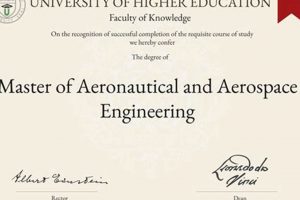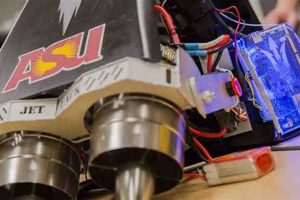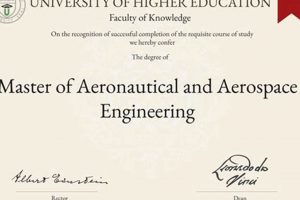This role involves the design, analysis, and testing of air and spacecraft structural components. Individuals in this profession ensure that aircraft and spacecraft can withstand the immense forces and stresses encountered during flight and operation. For instance, they may analyze the load-bearing capacity of a wing, determine the optimal materials for a fuselage, or conduct simulations to predict the behavior of a satellite under extreme temperature conditions.
Their contributions are crucial for ensuring the safety, reliability, and performance of air and space vehicles. Historically, advancements in structural design and materials science have directly enabled progress in aviation and space exploration. Improved structural integrity translates to lighter, more fuel-efficient aircraft and spacecraft capable of carrying heavier payloads and operating for extended durations. This directly impacts cost-effectiveness and the viability of ambitious aerospace missions.
The following discussion will delve into the specific challenges encountered in their work, the computational tools employed, and the evolving landscape of structural materials utilized in modern aircraft and spacecraft design.
Guidance on Aerospace Structural Integrity
The following recommendations are intended to provide a focused overview of best practices in aerospace structural engineering. These guidelines are critical for ensuring the safety and performance of aircraft and spacecraft.
Tip 1: Prioritize Comprehensive Load Analysis: A thorough understanding of all potential loads, including aerodynamic, inertial, and thermal stresses, is paramount. Consider both static and dynamic loading conditions to accurately predict structural response.
Tip 2: Implement Robust Material Selection Procedures: Carefully evaluate material properties such as strength, stiffness, density, and fatigue resistance. Consider the environmental conditions and potential for degradation over the lifespan of the structure. Document the selection process, detailing the justification for chosen materials.
Tip 3: Leverage Finite Element Analysis (FEA) for Detailed Stress Prediction: Employ FEA software to model complex geometries and loading scenarios. Validate FEA results with experimental testing to ensure accuracy and identify potential areas of concern.
Tip 4: Enforce Strict Adherence to Design Standards and Regulations: Familiarize with and strictly adhere to relevant regulatory requirements such as those established by the FAA, NASA, or ESA. Maintain meticulous documentation of all design decisions and compliance activities.
Tip 5: Integrate Damage Tolerance Principles: Design structures with inherent damage tolerance, enabling them to withstand localized damage without catastrophic failure. Incorporate redundant load paths and inspect critical components regularly.
Tip 6: Conduct Rigorous Structural Testing: Perform extensive ground-based and flight testing to validate structural integrity and identify potential weaknesses. Implement a comprehensive test plan that covers a range of operating conditions.
Tip 7: Emphasize Fatigue and Fracture Mechanics: Account for the effects of fatigue loading on structural life. Apply fracture mechanics principles to assess crack growth rates and determine inspection intervals. Implement proactive maintenance programs to mitigate fatigue-related failures.
Adhering to these principles fosters safer, more reliable aircraft and spacecraft. Continuous evaluation and refinement of these practices are essential for advancing aerospace technology.
The subsequent sections will elaborate on specific case studies and emerging technologies that are shaping the future of structural engineering.
1. Structural Analysis Expertise
Structural analysis expertise forms the bedrock of competence for those responsible for the design and integrity of air and spacecraft. This skillset encompasses the theoretical and practical application of engineering principles to assess the behavior of structures under various loading conditions, thereby ensuring safety, reliability, and performance.
- Finite Element Method (FEM) Proficiency
FEM is a numerical technique employed to approximate solutions to boundary value problems for engineering. Its application allows the modeling of complex geometries and material properties, enabling engineers to predict stress, strain, and displacement distributions within a structure under diverse loading scenarios. In the context of aircraft wing design, FEM is utilized to optimize the internal structure and skin thickness, reducing weight while maintaining necessary strength.
- Stress and Strain Analysis Capability
This involves the ability to calculate and interpret stress and strain distributions within structural components. A thorough understanding of these parameters is essential for predicting potential failure modes such as yielding, fracture, or buckling. For instance, during the design of a spacecraft’s pressure vessel, accurate stress analysis is critical to ensure it can withstand the internal pressure and external vacuum encountered in space.
- Load Path Determination Acumen
The capacity to identify and trace load paths within a structure is crucial for understanding how forces are distributed and managed. This skill informs the strategic placement of structural members and the selection of appropriate connection methods. Understanding load paths is critical when assessing the structural integrity of an aircraft fuselage subjected to aerodynamic loads, ensuring that the loads are effectively transferred through the structure to the wings and tail.
- Dynamic Analysis Competence
Dynamic analysis deals with the response of structures to time-varying loads, such as vibrations, shocks, and impacts. This competency is vital for mitigating resonance effects and ensuring structural stability under dynamic conditions. When designing rocket engines, dynamic analysis is crucial to prevent excessive vibrations that could lead to component failure during launch.
These facets collectively underscore the integral role of structural analysis expertise in ensuring the safe and efficient operation of aerospace vehicles. The application of these skills directly impacts the performance, longevity, and overall success of aerospace endeavors, emphasizing its importance in the work of any aerospace structures expert.
2. Material Science Knowledge
Material science knowledge forms a foundational element within the skill set of an aerospace structures professional. The effective design and analysis of air and spacecraft structures are contingent upon a comprehensive understanding of material properties, behavior under various environmental conditions, and manufacturing processes. Selection of appropriate materials directly impacts structural integrity, weight, cost, and overall performance. The ability to predict material response to stress, temperature fluctuations, radiation exposure, and other operational factors is crucial for ensuring long-term reliability and safety. For example, the transition from aluminum to carbon fiber reinforced polymers in aircraft fuselages reflects the application of material science principles to achieve significant weight reduction and improved fuel efficiency.
Furthermore, material selection considerations extend beyond static properties. Understanding fatigue resistance, corrosion susceptibility, and damage tolerance are critical in designing for longevity and minimizing maintenance requirements. The development of titanium alloys for high-stress components in jet engines exemplifies the integration of material science to withstand extreme temperatures and cyclic loading. Similarly, the use of ablative materials on spacecraft heat shields demonstrates the application of knowledge in thermal protection systems to endure the intense heat generated during atmospheric re-entry. Continued research in areas such as nanomaterials and shape memory alloys promises further advancements in aerospace structural design.
In conclusion, material science knowledge is not merely an adjunct skill but an intrinsic component of expertise in aerospace structures. Its proper application directly determines the performance, safety, and lifespan of aerospace vehicles. The successful integration of material science principles enables the realization of innovative designs and the attainment of increasingly ambitious aerospace objectives. Failure to consider material properties adequately can lead to catastrophic structural failures, underscoring the critical importance of this knowledge domain.
3. Design Optimization Skills
Design optimization skills are a critical competency for professionals responsible for aerospace structure development, enabling the creation of designs that maximize performance while minimizing weight, cost, and other critical parameters. These skills involve applying mathematical and computational techniques to systematically improve design solutions.
- Parametric Modeling and Analysis
This involves creating digital models where key dimensions and features are defined as parameters. This allows for efficient exploration of design variations and automated analysis of their performance characteristics. An example includes varying the wing airfoil shape and sweep angle of an aircraft in a simulation environment to identify configurations that minimize drag and maximize lift-to-drag ratio, thus improving fuel efficiency. This process allows for systematic exploration of the design space.
- Topology Optimization
Topology optimization is a mathematical approach that determines the optimal material distribution within a defined design space, subject to specified loads and constraints. This technique can be employed to identify the most efficient structural layout for a component, minimizing weight while meeting strength and stiffness requirements. Consider the design of an aircraft wing rib, where topology optimization can reveal a lightweight yet robust lattice structure that effectively transfers loads from the wing skin to the spar.
- Multi-Objective Optimization
Aerospace designs often involve conflicting objectives, such as minimizing weight while maximizing strength or reducing drag while maintaining stability. Multi-objective optimization techniques are used to find the best compromise solutions that balance these competing goals. In the design of a spacecraft heat shield, multi-objective optimization might be applied to simultaneously minimize weight, maximize thermal protection, and reduce manufacturing cost.
- Sensitivity Analysis
Sensitivity analysis involves determining how changes in design parameters affect the overall performance of the structure. This helps engineers to identify the most critical design variables and prioritize their efforts. For example, sensitivity analysis of an aircraft control surface hinge design can reveal which dimensions or material properties have the greatest impact on its fatigue life, enabling engineers to focus on improving those specific aspects.
These skills are integral to the task of creating efficient, robust, and reliable aerospace structures. When correctly implemented, design optimization leads to significant improvements in performance, cost reduction, and enhanced safety. The aerospace industry’s demand for lightweight, high-performance structures necessitates a continued focus on advancing these critical skills. Designs optimized for performance extend to the success of overall mission.
4. Regulatory Compliance Awareness
Regulatory compliance awareness is a fundamental component of the skill set required for success in the aerospace structures engineering field. This awareness dictates that every design, analysis, and manufacturing decision made by the engineer must conform to stringent industry standards and governmental regulations. The consequence of non-compliance can range from project delays and financial penalties to catastrophic failures jeopardizing lives and property. Governmental bodies, such as the FAA in the United States and EASA in Europe, establish airworthiness standards that dictate the minimum requirements for structural integrity, material selection, and manufacturing processes. Therefore, a comprehensive understanding of these regulations is not merely recommended but legally mandated for any professional involved in the development of aerospace vehicles. For instance, regulations concerning fire resistance in cabin interiors, or material traceability for critical structural components, directly impact design choices and material selection procedures.
Beyond mere adherence, regulatory compliance demands a proactive approach. Aerospace structures experts must anticipate future regulatory changes and adapt their practices accordingly. This requires continuous professional development and active participation in industry forums. Furthermore, the role necessitates meticulously documenting all design decisions, analysis results, and testing procedures to demonstrate compliance during audits and inspections. As an example, an alteration to an existing aircraft design, such as the installation of new avionics equipment, necessitates a thorough assessment of the structural impact and formal approval from regulatory agencies before implementation. This emphasizes that every modification, no matter how seemingly minor, must adhere to the established safety frameworks.
In summation, regulatory compliance awareness is not a supplementary skill but an intrinsic aspect of aerospace structural engineering. It safeguards public safety, ensures operational reliability, and mitigates legal and financial risks. Its practical significance lies in the continuous application of knowledge, foresight, and documentation to meet or exceed established safety standards, thereby ensuring the continued success and integrity of aerospace endeavors. Ignoring these regulations undermines the integrity of an Aerospace Structures expert and the safety of designs.
5. Testing and Validation Proficiency
Testing and validation proficiency is inextricably linked to the effectiveness of an aerospace structures professional. This skill set ensures that theoretical designs and computational analyses translate into robust, reliable, and safe air and spacecraft. Without rigorous testing and validation, the accuracy of design assumptions, the integrity of materials, and the overall structural performance remain unconfirmed, posing significant risks to flight safety and mission success. This proficiency involves a spectrum of activities, from component-level material testing to full-scale structural evaluations under simulated operational conditions. It requires the application of diverse testing methodologies, including destructive and non-destructive testing, vibration analysis, and environmental simulation, all interpreted through a strong understanding of structural mechanics and material behavior. For instance, the static testing of an aircraft wing to its ultimate load capacity validates its ability to withstand extreme aerodynamic forces, while fatigue testing assesses its long-term durability under cyclic loading. These tests provide empirical data that either confirms the validity of design models or identifies areas requiring refinement.
The practical significance of testing and validation extends beyond mere confirmation of design integrity. These processes serve as crucial feedback loops, informing design improvements and material selection strategies. Data acquired during testing can reveal unexpected failure modes, material weaknesses, or design flaws that were not apparent during the initial design phase. Consider the case of composite materials, where testing is essential to characterize their anisotropic properties and assess their susceptibility to delamination under various loading conditions. This knowledge informs the development of improved manufacturing processes and design guidelines for composite structures. Similarly, vibration testing of spacecraft components ensures that they can withstand the intense vibrations experienced during launch, preventing potential failures in orbit. The ability to interpret test data, identify anomalies, and propose corrective actions is therefore a hallmark of an experienced aerospace structures expert.
In conclusion, testing and validation proficiency is not an optional addendum but an indispensable element of the aerospace structures discipline. It bridges the gap between theoretical design and practical implementation, providing the empirical evidence necessary to ensure the safety and reliability of aerospace vehicles. As technology advances and designs become more complex, the need for robust testing and validation methodologies will only intensify, emphasizing the importance of this skill set for any aerospace structures expert. This proficiency presents challenges with cost and schedule, yet represents an undeniable requirement for safe and effective products.
Frequently Asked Questions Related to Aerospace Structures
This section addresses common inquiries and misconceptions concerning the professional practice of aerospace structural engineering. The information presented herein is intended to provide clarity and promote a better understanding of the field.
Question 1: What are the primary responsibilities of an individual specializing in aerospace structural engineering?
The core responsibilities involve designing, analyzing, and testing air and spacecraft structures to ensure their integrity under various operational conditions. This encompasses material selection, load analysis, finite element modeling, and adherence to regulatory standards.
Question 2: What educational background is typically required to pursue a career as an aerospace structures engineer?
A bachelor’s degree in aerospace engineering, mechanical engineering, or a related field is generally the minimum requirement. Many positions, particularly those involving research or advanced design, necessitate a master’s degree or doctorate.
Question 3: What software and tools are commonly employed by those working in aerospace structures?
Commonly utilized software includes finite element analysis (FEA) packages such as ANSYS and Abaqus, CAD software like CATIA and NX, and programming languages like MATLAB and Python for custom analysis and scripting.
Question 4: What are some of the key challenges encountered in aerospace structural design?
Significant challenges include minimizing structural weight while maximizing strength, ensuring fatigue resistance under cyclic loading, mitigating the effects of extreme temperatures, and adhering to stringent safety regulations.
Question 5: How does the field of aerospace structural engineering contribute to advancements in aviation and space exploration?
Innovations in structural design and materials science directly enable the development of lighter, more efficient aircraft and spacecraft, facilitating longer flights, heavier payloads, and more ambitious exploration missions.
Question 6: What are the primary regulatory bodies that govern aerospace structural design and certification?
Key regulatory bodies include the Federal Aviation Administration (FAA) in the United States, the European Union Aviation Safety Agency (EASA) in Europe, and various national aviation authorities worldwide.
This FAQ provided a concise overview of essential aspects of the profession. Aspiring professionals should pursue rigorous academic training and seek practical experience to excel in this demanding field.
The following section will examine real-world case studies illustrating the application of structural engineering principles in the aerospace industry.
Conclusion
This discussion has outlined the core competencies and responsibilities inherent in the role. From mastery of structural analysis and material science to proficiency in design optimization, regulatory compliance, and rigorous testing, the profession demands a comprehensive understanding of engineering principles and a commitment to precision. The impact extends beyond theoretical design, influencing the safety, performance, and longevity of aerospace vehicles.
Continued advancements in aerospace technology necessitate a persistent focus on refining these skills and embracing innovative solutions. A dedicated pursuit of knowledge and adherence to the highest standards remain crucial for ensuring the ongoing success and safety of future aerospace endeavors. Therefore, the continued development and rigorous application of these principles remains essential for the progression of the field.




![PSU Aero Eng: Your Recommended Academic Plan [Guide] Innovating the Future of Flight with Reliable Aviation Solutions PSU Aero Eng: Your Recommended Academic Plan [Guide] | Innovating the Future of Flight with Reliable Aviation Solutions](https://mixaerospace.com/wp-content/uploads/2025/12/th-843-300x200.jpg)


